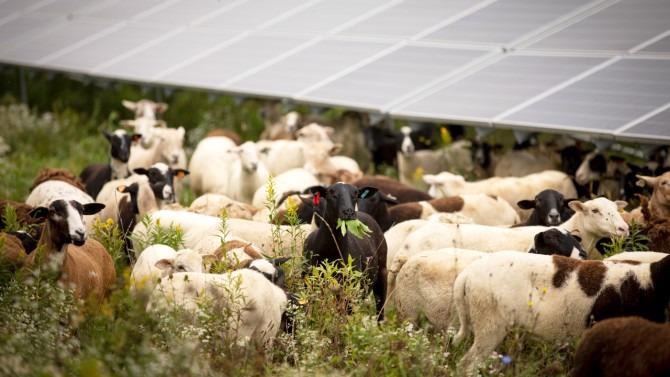Residents of the New York state fear the loss of agricultural land as they see industrial-sized solar installations popping up everywhere. Lexie Hain ’99 offers an elementary solution: sheep.
 A herd of sheep graze under an industrial-scale solar array in Newfield, New York. Image Credit: Lindsay France/Cornell University
A herd of sheep graze under an industrial-scale solar array in Newfield, New York. Image Credit: Lindsay France/Cornell University
“Sheep will rest in the shade of a solar panel just as well as under a tree; they don’t care,” said Hain, a farmer in the Finger Lakes region and executive director of the American Solar Grazing Association, a nonprofit trade group that links solar companies with shepherds.
Solar grazing is beneficial for a number of reasons:
- Companies gain by taking care of their landscapes without utilizing fossil fuels
- Shepherds receive money for grazing their livestock
- New Yorkers profit from clean energy while sustaining land in agricultural production
Recently, a Cornell scientist is collaborating with solar companies, farmers and the association to investigate the economic advantages of a business cooperative or producer-owned organization that could offer logistical and coordination services for farmers grazing under solar arrays.
Todd Schmit, associate professor in the Charles H. Dyson School of Applied Economics and Management and faculty director of Cornell’s Cooperative Enterprise Program, is leading a three-year, $500,000 project, financially backed by the Cornell University and the U.S. Department of Agriculture equally.
This idea complements the goals of reducing fossil fuel use in New York state and throughout the Northeast.
Todd Schmit, Associate Professor, Charles H. Dyson School of Applied Economics and Management, Cornell University
He continued, “There are literally thousands of acres going under new solar production, and I think increasing renewable energy production is a great thing, but it’s a little ironic if we’re promoting renewable energy production and then, because we need to control the vegetation, we’re going out there with mowers that are using fossil fuels or spraying it with pesticides that are killing the plants.”
Hain views this as an advantage for shepherds.
The farm businesses that have gotten these solar grazing contracts have expanded rapidly; oftentimes, they enable farmers to access land and a key new revenue source at once. Most farmers have to try to balance a lopsided income, where you’re paying bills year-round but maybe only earning income a few times a year. These checks from the solar companies are a stable source of revenue, and they really help.
Lexie Hain, Executive Director, American Solar Grazing Association
Hain said part of the challenge is bringing together a few large multinational solar companies and many small farmers. Of the approximately 2,000 sheep farms presently functioning in New York state, only 39 have over 300 sheep.
Solar companies don’t want to have to deal with 1,000 separate farmers, and most farmers don’t want to deal with the legal documents and logistics involved in working with these companies.
Lexie Hain, Executive Director, American Solar Grazing Association
Schmit believes this issue could be resolved by helping farmers create a producer-owned business cooperative that could negotiate contracts and share transportation gear. Other than grazing, the project will also investigate the possible benefits of farmers collectively producing and selling lamb, including sharing processing tools and forming a value-added brand for marketing “sheep produced under solar arrays.”
Over half of the mutton and lamb consumed in the United States is imported from New Zealand and Australia, so offering more market opportunities for local shepherds would profit the economy of New York, and decrease the carbon footprint of the sheep products consumed.
While Schmit’s project will concentrate on Pennsylvania, New York and the New England states, he anticipates lessons learned from the project will be beneficial to sheep farmers across the United States.
Before financial and business planning research can commence, Schmit said he will be meeting and working together with farmers across the Northeast to share thoughts and information. Roberta Severson, executive director of the Cornell Cooperative Enterprise Program in Dyson, will head those outreach efforts.
Coming to consensus among a potentially disparate group of farmers about their needs and goals for collective action is the first step to new cooperative development, and without it, the enterprise cannot move forward. As an economist, I think there’s a real opportunity for expansion of the industry, and an opportunity to bring new farmers into production agriculture.
Todd Schmit, Associate Professor, Charles H. Dyson School of Applied Economics and Management, Cornell University
Krisy Gashler is a writer for the College of Agriculture and Life Sciences.
Electric sheep: Grazing in solar arrays supports NY economy, climate
A new project backed by Cornell and the USDA will explore the economic benefits of grazing sheep under industrial-scale solar arrays. Video Credit: Lindsay France/Cornell University.